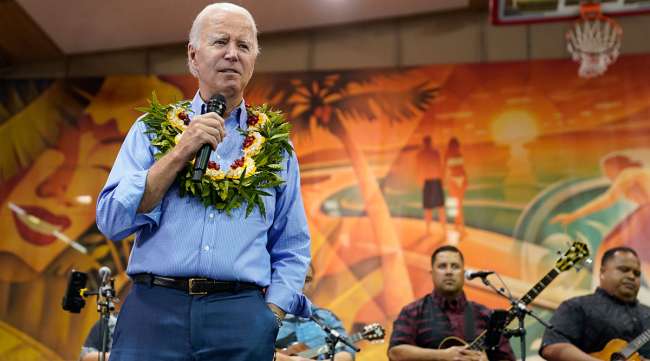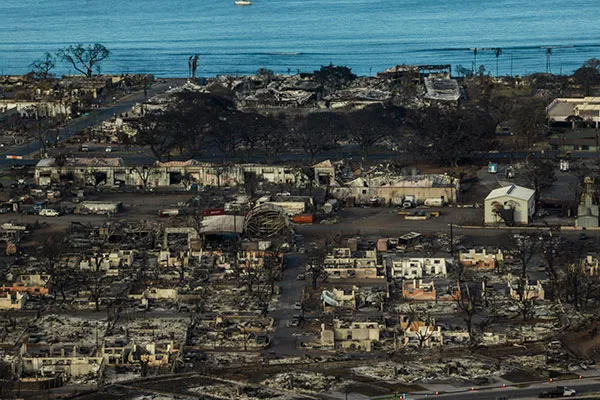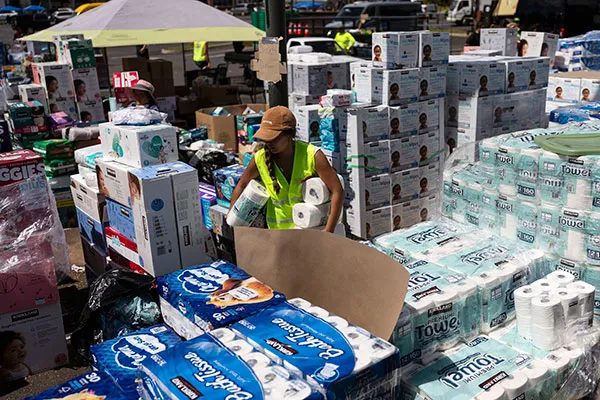Staff Reporter
Biden’s Visit to Hawaii Coincides With More Federal Relief

[Stay on top of transportation news: Get TTNews in your inbox.]
President Joe Biden’s visit Aug. 21 to fire-stricken Maui was bolstered by a $3 million Federal Highway Administration emergency grant and broad tax relief for people and businesses impacted by the disaster.
Amid a mounting death toll and hundreds missing since the Aug. 8 wildfires, Biden told Hawaii residents that “the country grieves with you, stands with you, and we’ll do everything possible to help you recover, rebuild and respect culture and traditions when the rebuilding takes place.”
Biden, who was accompanied by Gov. Josh Green to see devastation in the town of Lahaina, outlined various federal efforts to help fire victims.
“The Small Business Administration is making low-interest federal disaster loans available to Hawaiian businesses — many of them you see here — burned to the ground; homeowners and renters; and nonprofits,” the president said.
Join the First Lady and I as we participate in a community event with leaders, survivors, families, and organizations following devastating wildfires on Maui, Hawai'i. https://t.co/HJ0IOPUQBa — President Biden (@POTUS) August 22, 2023
Between $4 billion to $6 billion in losses are projected to result from the wildfires, according to an Aug. 22 estimate by Moody’s RMS, a top global integrated risk assessment company. This projection analyzed building-level damage from sources such as satellite and aerial images and state damage maps.
The greatest financial impact will be in Lahaina, which sustained a catastrophic urban fire torching over 2,100 acres in 12 hours and incinerating nearly 2,200 structures.
MORE: Hawaii Ports Tackle Relief Efforts, Container Congestion

An aerial photo taken Aug. 17 of Lahaina shows the devastation caused by the wildfires on the Hawaiian island of Maui. Between $4 billion to $6 billion in losses are projected to result from the wildfires (Associated Press/Jae C. Hong)
“Post-event loss amplification is expected to be high in this event due to the island effect on supply chains, high construction labor costs in general, inflationary impacts during the expected long recovery time, and potential ordinance and law requirements,” said Rajkiran Vojjala, Moody’s vice president of model development.
FHWA’s quick release of $3 million in emergency relief money is to help pay for traffic management services and infrastructure damaged by the wildfires.
Federal Highway Administrator Shailen Bhatt said Aug. 21 that the federal dollars will help emergency service personnel, police and other first responders get equipment in Lahaina and the surrounding area and fund future infrastructure repairs.

A volunteer works at a food and supply distribution center set up in the parking lot of a shopping mall in Lahaina on Aug. 16. (Associated Press/Jae C. Hong)
The Hawaii Department of Transportation revealed it will apply the federal grant to needed expenditures to maintain safe access to West Maui via Honoapiilani Highway (Hawaii Route 30) and the Lahaina Bypass (Hawaii Route 3000).
“We’re grateful for the continued support from our partners at FHWA and the speedy response to our request for emergency funding,” Ed Sniffen, HDOT director said Aug. 21. “The funding will ensure that we can minimize risks from dust, erosion and other factors to our emergency responders, residents and others that need to go to West Maui.”
The people of Lāhainā will need time to heal, to recover and to grieve. Like we’ve been sharing, and as President Biden said yesterday, Lāhainā belongs to its people and we are committed to rebuilding Lāhainā the way the people of Lāhainā want. pic.twitter.com/rPhmYpSSD0 — Governor Josh Green (@GovJoshGreenMD) August 22, 2023
Other federal assistance came from an Internal Revenue Service announcement that Hawaiian wildfire victims now have until Feb. 15, 2024, to file various individual and business tax returns and delay some tax payments.
Following the Federal Emergency Management Agency’s disaster declaration, individuals and households affected by wildfires that live or have a business in the counties of Maui and Hawaii qualify for federal tax relief.
“The IRS automatically identifies taxpayers located in the covered disaster area and applies filing and payment relief. But affected taxpayers who reside or have a business located outside the covered disaster area should call the IRS disaster hotline at 866-562-5227 to request this tax relief,” the agency stated.
Want more news? Listen to today's daily briefing below or go here for more info:




